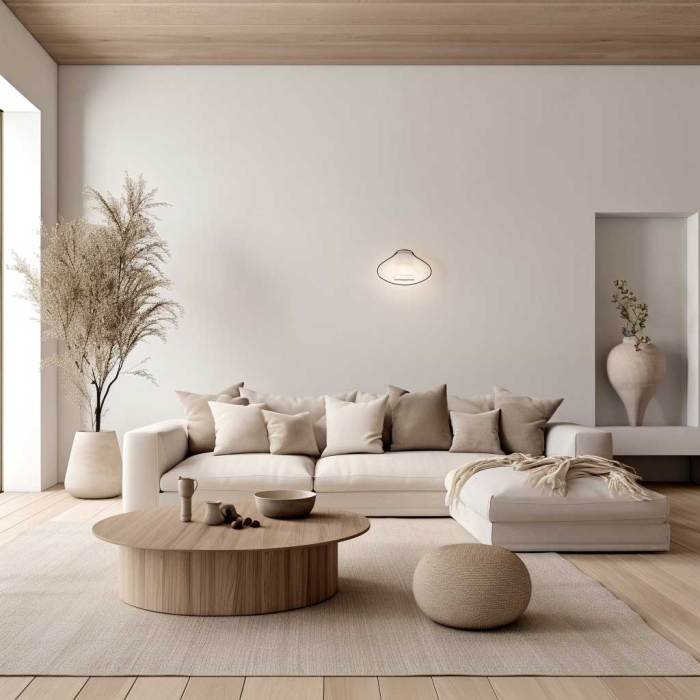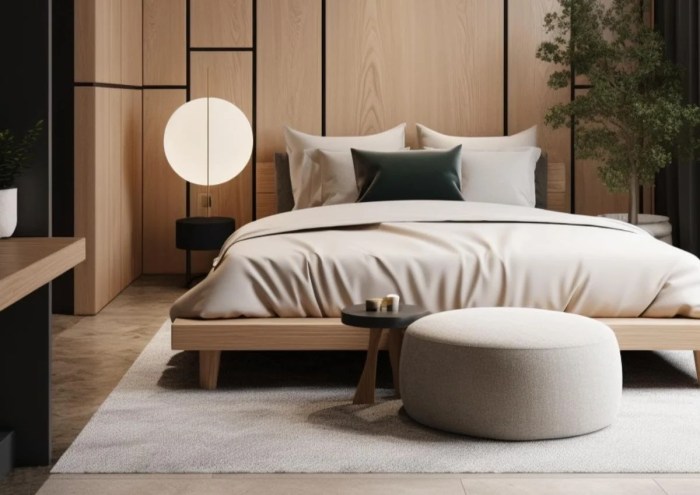Japandi Style Where Minimalism Meets Warmth
With Japandi Style: Where Minimalism Meets Warmth at the forefront, we invite you to discover a design philosophy that beautifully marries the serene aesthetics of Japanese tradition with the functional simplicity of Scandinavian design. This harmonious blend creates spaces that are not only visually stunning but also deeply comforting, making them perfect sanctuaries in our busy lives.
Originating from the need for a more mindful approach to living, Japandi reflects a desire for tranquility and warmth. Characterized by clean lines, natural materials, and a neutral color palette, it emphasizes simplicity while incorporating elements that evoke a sense of home. As we explore this style, we will uncover the key elements that define Japandi, from furniture choices to the perfect color schemes.
Introduction to Japandi Style
Japandi style is a harmonious blend of Japanese and Scandinavian design aesthetics, emerging as a popular trend in interior design. This unique fusion prioritizes simplicity, functionality, and a deep appreciation for craftsmanship, resulting in spaces that feel both serene and inviting. Over the years, Japandi has evolved from a niche concept into a defining style that resonates with those seeking tranquility and balance in their living environments.The origins of Japandi can be traced back to the minimalist philosophies of Japanese design, which emphasize the beauty of nature and the significance of each crafted object.
Meanwhile, Scandinavian design contributes its own principles of functionality and warmth, often seen through the use of light colors and natural materials. Together, these influences create a design ethos where less truly becomes more, fostering spaces that are not only aesthetically pleasing but also deeply functional.
Core Characteristics of Japandi Style
Understanding the core characteristics of Japandi style is crucial to appreciating its appeal. The following elements are fundamental in defining this design approach:
- Simplicity: Japandi embraces minimalism, stripping away unnecessary clutter and focusing on clean lines and open spaces. This simplicity fosters a sense of calm and order, making it ideal for modern living.
- Natural Materials: Emphasizing sustainability, Japandi favors natural materials such as wood, bamboo, and stone. These elements not only add warmth but also create a connection with nature.
- Neutral Color Palette: Soft tones and muted colors are at the heart of Japandi style. Shades like beige, gray, and soft pastels promote tranquility and allow for easy integration of various design elements.
- Functional Beauty: Each piece of furniture or decor is chosen for its practicality as well as its aesthetic appeal. This reflects the idea that beauty should serve a purpose.
- Craftsmanship: There is a strong appreciation for handcrafted items in Japandi style. This focus on quality over quantity highlights the value of well-made objects that tell a story.
The blend of these characteristics creates environments that are not only beautiful but also enhance well-being, making Japandi a sought-after style for those looking to cultivate a soothing retreat at home.
Key Elements of Japandi Style
Japandi style beautifully blends the minimalistic principles of Japanese design with the cozy, rustic elements of Scandinavian aesthetics. This harmonious fusion creates spaces that are not only visually appealing but also deeply comforting. Essential to understanding Japandi is an appreciation for simplicity, functionality, and the warmth that natural materials bring to an interior.One of the distinguishing features of Japandi style is its focus on clean lines, uncluttered spaces, and organic forms.
This design ethos promotes a sense of tranquility, making it a perfect choice for those seeking to create a peaceful sanctuary. Central to this style is the use of natural materials, which are essential for achieving the desired warmth and authenticity in Japandi interiors.
Main Features of Japandi Design
Natural materials play a pivotal role in Japandi interiors, enhancing both aesthetic appeal and emotional comfort. The use of wood, stone, and textiles made from natural fibers invites a sense of nature indoors. These elements not only add texture but also create a soothing atmosphere.Common materials featured in Japandi style include:
- Wood: Light-toned woods like oak and birch are favored for their warmth and durability, often seen in furniture and flooring.
- Stone: Natural stone is used in countertops and decor, adding a feeling of permanence and connection to the earth.
- Textiles: Organic fabrics like linen and cotton are predominant, providing comfort and softness to a space.
Color Palettes in Japandi Design
The color palettes that complement Japandi design reflect the simplicity and serenity inherent to this style. These palettes often draw from nature, promoting a sense of calm and balance throughout the space. Examples of effective color combinations include:
- Earthy Neutrals: Shades of beige, taupe, and soft grey create a warm foundation, allowing room for other design elements to shine.
- Muted Pastels: Soft blues, greens, and blush tones introduce a subtle touch of color without overwhelming the senses.
- Deep Accents: Richer colors like navy or forest green can be used sparingly as accent walls or accessories, providing depth and contrast.
The overall effect of these colors is to create a cohesive, inviting atmosphere that echoes the tranquility found in nature, embodying the very essence of Japandi style.
Furniture and Decor in Japandi Style

Source: artfasad.com
In Japandi style, furniture and decor play a crucial role in establishing a serene and harmonious environment. This design philosophy merges the clean lines of Scandinavian minimalism with the warmth of Japanese aesthetics, resulting in spaces that are not only functional but also deeply comforting. Selecting the right furniture and decorative pieces is essential to achieving this balance.The types of furniture used in Japandi interiors emphasize simplicity, functionality, and natural materials.
Furniture pieces often feature organic shapes and are designed to complement the overall tranquility of the space.
Types of Furniture in Japandi Style
Furniture in Japandi style is characterized by its combination of form and function. The following types are commonly found:
- Low-profile sofas: These often have clean lines and are upholstered in neutral colors or natural fabrics, promoting a sense of calm.
- Wooden tables: Crafted from light or dark woods, these tables often showcase natural grain patterns and are typically simple in design.
- Functional storage units: Minimalistic bookcases and cabinets that provide ample storage without overwhelming the room.
- Japanese tatami mats: Used for seating areas or as flooring, these mats add texture and authenticity to the space.
- Accent chairs: Simple, yet stylish chairs that blend comfort with a minimalist aesthetic, often made from wood or rattan.
In addition to furniture, decorative accessories enhance the Japandi aesthetic and contribute to the overall ambiance. These pieces should reflect the same principles of simplicity and warmth.
Decorative Accessories in Japandi Style
Decorative accessories in Japandi style are thoughtfully selected to enhance the serene atmosphere. The following items are commonly used:
- Textiles: Natural fibers such as linen and cotton are preferred for cushions and throws, adding warmth without cluttering the space.
- Plants: Indoor plants like bonsais or succulents infuse life into the decor while maintaining a minimal footprint.
- Ceramic vases: Simple, handcrafted vases can be used to display flowers or stand alone as art pieces.
- Wall art: Minimalist art pieces or calligraphy that celebrate nature and simplicity can effectively complement the decor.
- Lighting: Soft, ambient lighting such as lanterns or pendant lights made from natural materials create a cozy atmosphere.
When selecting furniture for a Japandi-inspired space, it is important to adhere to a few design tips that resonate with the style’s core principles.
Design Tips for Selecting Furniture
Choosing the right furniture for a Japandi style interior involves a few key considerations.
- Prioritize natural materials: Opt for furniture crafted from wood, bamboo, or rattan to foster a connection with nature.
- Focus on functionality: Each piece should serve a purpose, thereby reducing clutter and enhancing the overall sense of tranquility.
- Maintain a neutral palette: Choose colors like beige, grey, and earthy tones to promote a soothing environment.
- Embrace simplicity: Look for designs that are minimalistic, avoiding overly ornate or complex styles.
- Consider scale: Ensure furniture pieces are appropriately scaled to the space, avoiding oversized items that can overwhelm the room.
By thoughtfully selecting furniture and decor that embody these principles, one can create a harmonious Japandi space that feels both inviting and serene.
Creating a Japandi-Inspired Space

Source: citynomads.com
Transforming a room into a Japandi haven requires an understanding of the core principles of this design aesthetic. The fusion of Japanese minimalism and Scandinavian warmth creates environments that are both serene and inviting. To achieve a balanced Japandi space, consider the harmony of colors, materials, and the thoughtful arrangement of furniture and decor.A successful Japandi-inspired room is not just about minimalism or maximizing warmth; it’s about striking a perfect balance between the two.
Start by decluttering the space, removing unnecessary items, and focusing on essential pieces that offer function and beauty. This process sets the stage for an environment that feels open yet cozy.
Steps to Transform a Room
To effectively create a Japandi-inspired space, follow these essential steps that emphasize simplicity and comfort. Each step plays a crucial role in harmonizing the room’s atmosphere.
- Declutter: Begin by removing excess items that do not serve a purpose or bring joy. Aim for a clean slate to enhance the feeling of spaciousness.
- Choose a Color Palette: Select neutral tones such as soft whites, muted greys, and earthy hues. These colors reflect the natural elements that are fundamental to Japandi style.
- Integrate Natural Materials: Use wood, bamboo, and stone to add texture and warmth. Furnishings and decor made from these materials promote a connection to nature.
- Opt for Functional Furniture: Invest in multi-functional furniture that embodies simplicity and usability. Pieces like a low-profile sofa or a simple wooden coffee table work beautifully.
- Create Zones: Arrange furniture to define different areas, allowing for easy movement while maintaining a sense of openness.
Balancing Minimalism and Warmth
Achieving a harmonious blend of minimalism and warmth in your interior layout is crucial for a true Japandi feel. This balance can be struck through careful selection and arrangement of decor and furnishings.
“Simplicity is the ultimate sophistication.”
To foster this balance, focus on these key strategies:
- Layer Textures: Incorporate various textures such as soft linens, warm woods, and ceramics to create depth without cluttering the space.
- Utilize Soft Lighting: Use warm lighting fixtures, like paper lanterns or pendant lights, to create a cozy atmosphere while maintaining a clean aesthetic.
- Incorporate Thoughtful Decor: Choose a few well-curated decorative pieces, such as a handcrafted vase or a simple wall art, to provide visual interest without overwhelming the senses.
Incorporating Plants and Greenery
Integrating plants into a Japandi design not only enhances aesthetic appeal but also brings life and warmth to the space. Thoughtful placement of greenery can elevate the overall ambiance.To effectively include plants, consider the following suggestions:
- Select Low-Maintenance Plants: Choose plants like snake plants or pothos that thrive in various conditions and require minimal care, making them ideal for a tranquil environment.
- Group Plants Strategically: Arrange plants in groups of varying heights to create visual interest and layers while ensuring they complement existing decor.
- Utilize Natural Planters: Use ceramic or wooden planters that align with the Japandi style and enhance the natural feel of the space.
- Hang Plants: Consider hanging planters in windows or from ceilings to save space while adding greenery that draws the eye upward, creating an illusion of more height.
Color Schemes and Textures in Japandi Style
In Japandi style, the careful selection of colors and textures plays a vital role in creating a serene and inviting atmosphere. This design approach marries the sleekness of Japanese aesthetics with the coziness of Scandinavian warmth, resulting in spaces that feel both modern and homely. The colors chosen not only define the visual appeal but also influence the mood within a space.Color choices in Japandi interiors typically revolve around a palette that embodies neutrality and subtle warmth.
Soft, muted tones are favored, often evoking a sense of calm and balance. Richer, earthy shades may be introduced to accentuate certain areas, providing a contrast that enhances the overall ambiance.
Effective Use of Textures in Minimalist Spaces
Incorporating a variety of textures is essential to counterbalance the simplicity of minimalism. While Japandi emphasizes clean lines and uncluttered surfaces, the introduction of different materials can add depth and warmth. Natural materials such as wood, stone, and textiles are commonly used to create tactile experiences. For instance, a light oak dining table paired with linen cushions can create a comforting dining area.
Adding soft throws or rugs in natural fibers can enhance the feeling of coziness, inviting people to linger in the space.The significance of textures in Japandi style cannot be overstated; they transform a stark environment into one that feels welcoming and lived-in. Layering textures—like a woven basket next to a smooth ceramic vase—can create visual interest without overwhelming the minimalist aesthetic.To illustrate how color combinations can influence Japandi interiors, the following table presents various palettes that embody the essence of this style:
| Color Combination | Description |
|---|---|
| Soft Beige and Cream | A gentle and neutral base that promotes tranquility. |
| Charcoal Gray and Warm Wood | Creates a modern, yet inviting look; ideal for urban settings. |
| Muted Green and Earthy Terracotta | Brings nature indoors, adding warmth and life to spaces. |
| Dusty Blue and White | A fresh and airy palette that fosters a peaceful vibe. |
| Rich Brown and Soft Cream | A warm, cozy combination that enhances comfort in living areas. |
By thoughtfully selecting colors and incorporating diverse textures, one can fully embrace the Japandi style, achieving a balance between minimalism and warmth that makes a space feel both elegant and inviting.
Lighting in Japandi Design
Lighting plays a vital role in Japandi design, harmonizing minimalism with warmth and creating an inviting atmosphere. Thoughtful lighting choices can enhance the serene and functional qualities that define this style. By focusing on both natural and artificial light, you can achieve a beautifully balanced space that fosters comfort and tranquility.
Types of Lighting that Complement Japandi Style
In Japandi design, lighting should feel understated yet impactful. The right fixtures not only provide illumination but also enhance the aesthetic of the space. Consider incorporating the following types of lighting:
- Pendant Lights: Simple and elegant pendant lights made from natural materials, such as wood or ceramic, embody Japandi aesthetics. They can serve as statement pieces above dining tables or kitchen islands.
- Floor Lamps: Tall, slender floor lamps with soft, diffused light add warmth and dimension to living areas. Look for designs with wooden bases or woven shades to maintain a natural feel.
- Table Lamps: Minimalistic table lamps with clean lines can be placed on side tables or desks. Choose lamps with neutral colors and textures that blend seamlessly with the overall decor.
- Wall Sconces: Wall sconces provide ambient light while saving floor space. Select sconces that reflect the simplicity and craft of Japandi design, ideally with a soft glow that enhances the mood.
- Natural Light: Maximize natural light by using sheer curtains or not obstructing windows. This connection to nature is essential in Japandi spaces, inviting the outside in.
Layering Light for a Cozy Atmosphere
Creating a cozy environment in a Japandi-inspired space involves layering different types of lighting. This technique allows for versatility in mood and functionality. Here are methods to achieve effective layering:
- Ambient Lighting: Establish a base layer of ambient lighting with ceiling fixtures or recessed lights. This provides overall illumination and sets the foundation for the space.
- Task Lighting: Incorporate task lighting, such as reading lamps or under-cabinet lights in the kitchen, to illuminate specific areas. This ensures functionality while maintaining the uncluttered aesthetic.
- Accent Lighting: Use accent lighting to highlight artwork, plants, or architectural details. This adds visual interest and depth, enhancing the overall design.
- Dimming Options: Install dimmer switches to adjust the brightness according to the time of day or activity. Soft, warm light in the evening can create a serene and inviting atmosphere.
Lighting Fixtures that Embody Japandi Aesthetics
Choosing lighting fixtures that reflect the principles of Japandi style can significantly enhance the overall design. Look for pieces that are characterized by simplicity, natural materials, and craftsmanship. Some exemplary fixtures include:
- Wooden Pendant Lights: Fixtures crafted from light woods, such as beech or oak, provide a warm glow and fit perfectly within the Japandi ethos.
- Minimalist Lanterns: Lantern-style fixtures, especially those with paper or fabric shades, can soften the light and add a touch of traditional Japanese influence.
- Modern Sculptural Lamps: Sculptural designs that balance form and function can serve as conversation pieces while adhering to the minimalist aesthetic.
- Woven Light Fixtures: Natural fibers woven into light fixtures bring texture and warmth to spaces, reflecting the organic influences of Japandi design.
Sustainability in Japandi Style
In a world increasingly aware of environmental issues, Japandi style stands out not only for its aesthetic appeal but also for its commitment to sustainability. This design philosophy beautifully merges Japanese minimalism with Scandinavian functionality, creating spaces that are not only visually pleasing but also environmentally conscious. By focusing on sustainability, Japandi style embraces practices that honor the earth while fostering a sense of tranquility and warmth in homes.Sustainability plays a vital role in the principles of Japandi design, emphasizing the use of eco-friendly materials and sustainable practices.
The essence of Japandi revolves around simplicity, quality over quantity, and a deep connection to nature. This respect for the environment encourages the selection of materials that are renewable, recycled, or sustainably sourced. Through thoughtful design choices, Japandi inspires individuals to create spaces that are both beautiful and responsible.
Eco-Friendly Materials in Japandi Style
Selecting materials that align with Japandi principles is essential for a sustainable home. The following materials are commonly used in Japandi design, offering eco-friendly options that do not compromise on aesthetics or functionality:
- Bamboo: A rapidly renewable resource, bamboo is strong, durable, and adds a natural touch to any space.
- Reclaimed Wood: Utilizing reclaimed wood reduces waste and gives a unique character to furniture, ensuring that no two pieces are alike.
- Natural Fibers: Materials like cotton, linen, and wool are biodegradable and often produced with minimal environmental impact.
- Low-VOC Paints and Finishes: These products reduce harmful emissions, contributing to a healthier indoor environment.
Incorporating these materials not only aligns with the aesthetic values of Japandi style but also promotes a healthier planet.
Sustainable Japandi Furniture Brands
Several brands are dedicated to creating sustainable furniture that embodies Japandi style. These companies focus on quality craftsmanship and eco-friendly practices, producing pieces that offer both style and sustainability. Here are a few noteworthy examples:
- Muuto: This Scandinavian brand emphasizes modern design with sustainable materials, offering furniture that is functional and stylish.
- Ethnicraft: Known for their beautiful wooden furniture, Ethnicraft uses sustainably sourced timber and focuses on responsible manufacturing processes.
- Floyd: Offering modular and customizable furniture, Floyd prioritizes sustainability and durability in their products.
- HAY: HAY combines contemporary design with environmental consciousness, providing a range of products that reflect Japandi aesthetics.
These brands demonstrate that sustainability and style can coexist, allowing individuals to create Japandi-inspired spaces that reflect their values.
“The true beauty of a home lies in its intentional design, where every piece serves a purpose and tells a story.”
Japandi Style in Different Rooms

Source: homestratosphere.com
The beauty of Japandi style lies in its versatility, allowing it to breathe life into various spaces within a home. Each room can embody the serene blend of minimalism and warmth that characterizes this design aesthetic. Whether you are transforming a living room, bedroom, or kitchen, adapting Japandi principles can create a harmonious environment that feels both inviting and functional.
Living Room
The living room serves as the heart of the home, where comfort meets elegance. To infuse Japandi style into this space, focus on selecting furniture that combines sleek lines with natural materials. A low-profile sofa upholstered in a neutral fabric can provide a cozy yet sophisticated seating area. Incorporate wooden furniture, such as a coffee table with a light finish, to enhance the warm aspect of Japandi.
Complement these pieces with a few well-chosen decorative items, like ceramic vases or woven baskets, to maintain a clutter-free environment while adding character.To ensure functionality, consider the layout carefully. Opt for multipurpose furniture, like an ottoman that can serve as both a footrest and storage. Keep decorative accents to a minimum, emphasizing quality over quantity to create a serene atmosphere.
Bedroom
A Japandi-inspired bedroom is a sanctuary for relaxation and rejuvenation. Start with a low bed frame made from natural wood to establish a grounding element in the room. Soft bedding in muted tones can enhance the tranquil vibe. It’s essential to balance aesthetics with functionality in this personal space. Consider using built-in storage solutions to keep the room organized and clutter-free.
Nightstands with clean lines and minimal decor can add practicality without overwhelming the senses. Lighting plays a pivotal role in setting the mood. Utilize warm, soft lighting options like paper lanterns or understated bedside lamps to create a calming ambiance, inviting restful nights.
Kitchen
Incorporating Japandi style into the kitchen focuses on simplicity and practicality. Opt for cabinetry in light woods or muted colors, ensuring clean lines that promote an uncluttered look. Choose open shelving to display a curated selection of cookware and dishware, allowing them to become part of your decor.The kitchen island can serve as a multifunctional space, providing extra prep space while doubling as a casual dining area.
Use natural materials like stone or wood to maintain harmony with the Japandi ethos.To enhance functionality, consider smart appliances that blend seamlessly into the design. A well-organized kitchen with a few choice, high-quality utensils can embody the Japandi principle of simplicity, focusing on what matters most.
Implementing Japandi in Smaller Spaces
Adapting Japandi style in smaller spaces requires thoughtful planning to maximize functionality without sacrificing aesthetic appeal. Limit the number of large furniture pieces to create a more open feel. Instead, use modular furniture that can easily be rearranged or expanded as needed.Incorporate mirrors to reflect light and create an illusion of spaciousness. Choosing light color palettes can also contribute to a sense of openness, making the area feel larger and more inviting.
Maintaining Functionality While Adhering to Japandi Aesthetics
Achieving a balance between functionality and the aesthetics of Japandi design is vital in any space. Focus on selecting high-quality, versatile furniture that serves multiple purposes. Keep decorative elements minimal yet meaningful, ensuring each item contributes to the overall ambiance. Utilize natural light as much as possible, and incorporate smart storage solutions to maintain an organized, serene environment.By emphasizing quality, natural materials, and a thoughtful arrangement of space, it is possible to create environments that are not only visually appealing but also functional and comfortable, embodying the best of Japandi style.
Common Misconceptions about Japandi Style
Japandi style, a harmonious blend of Japanese and Scandinavian aesthetics, often comes with a set of misconceptions that can cloud its beauty and purpose. Understanding these myths can help enthusiasts appreciate the true essence of this design philosophy. By debunking the prevailing myths, we can celebrate the unique features that make Japandi a refreshing choice for many homes.One common misconception is that Japandi is merely a trend or a passing fad.
In reality, Japandi is rooted in centuries of cultural practices and design philosophies, emphasizing simplicity and functionality. It is essential to distinguish Japandi from other minimalistic styles, as it brings together warmth and coziness, distinguishing it from the often cold and stark nature of traditional minimalism.
Differences between Japandi and Other Minimalistic Styles
While minimalism focuses on reducing clutter and emphasizing simplicity, Japandi intertwines this with elements of comfort and organic materials. The key differences are as follows:
- Warmth vs. Starkness: Japandi promotes a warm environment through the use of natural materials, colors, and textures. Traditional minimalism may feel cold and impersonal, while Japandi invites comfort.
- Functionality and Aesthetics: Japandi merges utility with beauty, whereas other minimalistic styles may prioritize function over form.
- Emotional Connection: Japandi fosters an emotional bond with its surroundings, incorporating elements that resonate with personal history and culture.
Versatility of Japandi in Various Cultural Contexts
Japandi’s appeal extends across different cultural landscapes, allowing for adaptability while staying true to its roots. This versatility enables individuals from various backgrounds to incorporate Japandi elements into their homes. The following aspects illustrate this adaptability:
- Integration with Local Materials: Japandi can seamlessly blend with the natural materials specific to different cultures, enhancing its charm and relevance.
- Mixing Styles: It allows for the fusion of local decor traditions, creating harmonious spaces that reflect both cultural heritage and modern sensibilities.
- Personalization: Homeowners can infuse their unique stories and experiences into their Japandi-inspired spaces by choosing decor items that resonate with their backgrounds.
“Incorporating Japandi style is not merely about aesthetics; it is about creating spaces that nurture and inspire.”
Resources for Japandi Style Enthusiasts
For those eager to delve deeper into the serene and harmonious world of Japandi design, a wealth of resources is available. These materials not only enhance understanding but also inspire creativity in creating Japandi-inspired spaces. Whether through books, online platforms, or workshops, these resources are invaluable for any enthusiast.Exploring Japandi design can be enriched by various influential books and online platforms that showcase this unique aesthetic.
These resources highlight key concepts, practical applications, and the philosophy behind the style, making them essential for anyone looking to embrace Japandi.
Books and Online Platforms
A range of insightful books and online platforms can provide comprehensive knowledge about Japandi design. Below is a selection of notable resources:
- Books:
- Japandi: A Guide to the Japanese-Scandinavian Design Aesthetic by Tori M. Kline – This book covers the essential elements of Japandi and how to incorporate them into your home.
- Scandinavian Design: A History by A. M. H. Collins – Offers insights into Scandinavian design roots, which are integral to understanding Japandi.
- Wabi-Sabi: For Artists, Designers, Poets & Philosophers by Leonard Koren – Focuses on the Japanese philosophy of wabi-sabi, a crucial aspect of Japandi style.
- Online Platforms:
- Houzz
-A platform filled with images and articles that inspire Japandi design elements. - Pinterest
-A visual haven for discovering and saving Japandi-inspired décor ideas. - Instagram
-Following hashtags like #Japandi and #JapandiStyle brings direct access to contemporary interpretations and community discussions.
- Houzz
Influential Designers and Influencers
The Japandi design community thrives with influential designers and social media influencers who embody this style. Their work and insights can guide enthusiasts toward authentic Japandi aesthetics. Here are notable figures in the field:
- Designers:
- Nitori
-Often referred to as the “IKEA of Japan,” their designs reflect a seamless blend of Japanese and Scandinavian aesthetics. - Muji
-Known for minimalist design principles, Muji incorporates Japandi elements in their product lines.
- Nitori
- Influencers:
- Becky from @minimalistbaker
-Shares a lifestyle that includes Japandi elements and encourages followers to embrace minimalism. - Erin from @designbythesea
-Focuses on creating tranquil spaces inspired by the Japandi aesthetic.
- Becky from @minimalistbaker
Workshops and Events
Participating in workshops or events dedicated to Japandi style can foster a deeper understanding and practical skills for design enthusiasts. These experiences often cover hands-on activities and expert insights. Here are some recommended options:
- Workshops:
- Online Classes by Skillshare
-Various classes focus on Japanese and Scandinavian design principles. - Local Design Schools
-Many offer workshops on minimalist design, including Japandi style elements.
- Online Classes by Skillshare
- Events:
- Design Festivals
-Events like the London Design Festival often feature Japandi-inspired installations and discussions. - Home and Garden Shows
-These exhibitions may include sections dedicated to contemporary Japandi design themes.
- Design Festivals
Last Point
In summary, Japandi Style: Where Minimalism Meets Warmth offers a unique perspective on modern design, encouraging us to create spaces that are both functional and inviting. By embracing the core principles of this style, we can transform our homes into serene retreats that celebrate the beauty of simplicity and warmth. Let this guide inspire you to explore Japandi design and fill your space with tranquility and comfort.
FAQ Corner
What is the main difference between Japandi and other minimalistic styles?
Japandi combines Japanese and Scandinavian elements, focusing on warmth and comfort, while many minimalistic styles may prioritize starkness and simplicity alone.
Can Japandi style work in smaller spaces?
Yes, Japandi can be adapted to smaller spaces by using multifunctional furniture and maintaining a balanced layout that promotes openness.
What colors are commonly used in Japandi interiors?
Neutral tones such as beige, gray, and soft earth tones are popular, complemented by deep blues and greens for accents.
Is sustainability a key aspect of Japandi style?
Absolutely, sustainability is essential in Japandi design, emphasizing the use of eco-friendly materials and practices.
How can I incorporate plants into a Japandi space?
Incorporating plants can enhance the natural feel of Japandi; choose simple, organic shapes in earthy pots to maintain the aesthetic.









